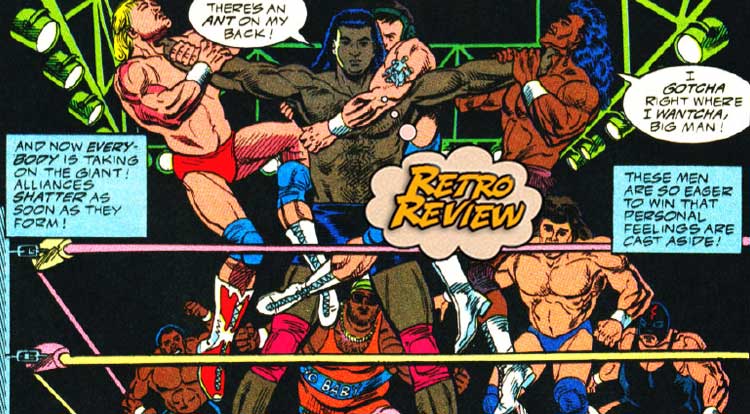Sometimes, you can love two things with all your heart and your spleen, and yet they just…
Don’t. Go. Together.
Your Major Spoilers (Retro) Review of WCW: World Championship Wrestling #1 awaits!
 WCW: WORLD CHAMPIONSHIP WRESTLING #1
WCW: WORLD CHAMPIONSHIP WRESTLING #1
Writer: Mike Lackey
Penciler: Ron Wilson
Inker: Don Hudson
Colorist: Nel Yomtov
Letterer: Phil Felix
Editor: MIke Rockwitz
Publisher: Marvel Comics
Cover Price: $1.25
Current Near-Mint Pricing: $3.00
Previously in WCW: World Championship Wrestling #1: Spinning out of a chapter of the regional National Wrestling Alliance, WCW was bankrolled by media mogul Ted Turner, who threw an inordinate amount of money into the organization in the hopes of offsetting the pop culture footprint of the World Wrestling Federation, long the only national game in town. Hiring the best and brightest (and also their friends and sycophants, a number of guys far over the hill whose name value was at least interesting and a literal army of muscleheads with varying gimmicks to lose to the best and brightest), WCW stood for over a decade as “the other wrestling guys.” But what does that mean for fans who eagerly picked up their comic during my senior year at college?
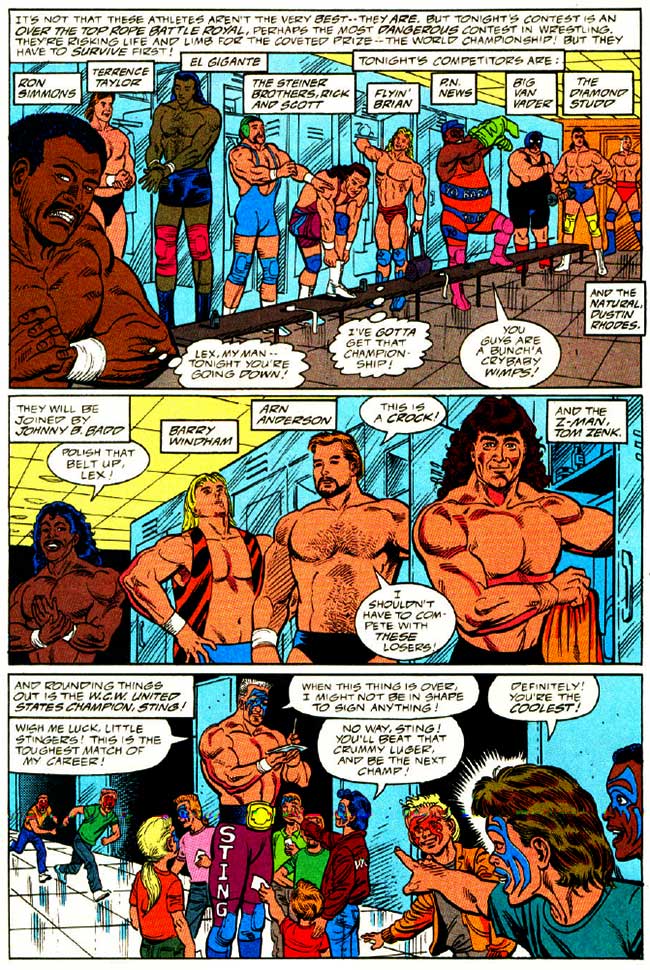
Well, mostly it means a scorecard, without which you just can’t tell your players. This is well before the days of The Outsiders, Hulk Hogan and many of the players that would make the Monday Night Wars a going concern in wrestling (although if you look closely, Outsider Scott Hall is in these pages in his Diamond Studd gimmick.) The reason for their gathering is simple: An over-the-top rope Battle Royale (the term ‘Royal Rumble’ is intellectual property of WWF, bee tee dubs) to determine the number one contender for the World Heavyweight Championship, as explained by our ringside commentary team.
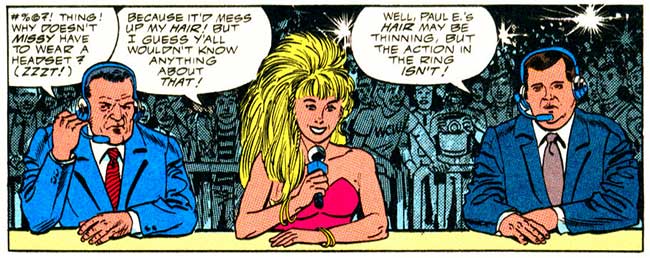
One rule of watching wrestling is that Jim Ross, when he’s on commentary, makes even the most terrible matches better, and the presence of Paul E. Dangerously (AKA Paul Heyman, the mastermind of ECW and the current mouthpiece for a current world champion as of the fall of 2017) is entertaining as well. As for the action in the ring, we quickly discover that the best parts of wrestling (the technical work, the high-flying action, the psychology built by chains of moves and action by the participant) simply don’t translate into panel-by-panel sequences…
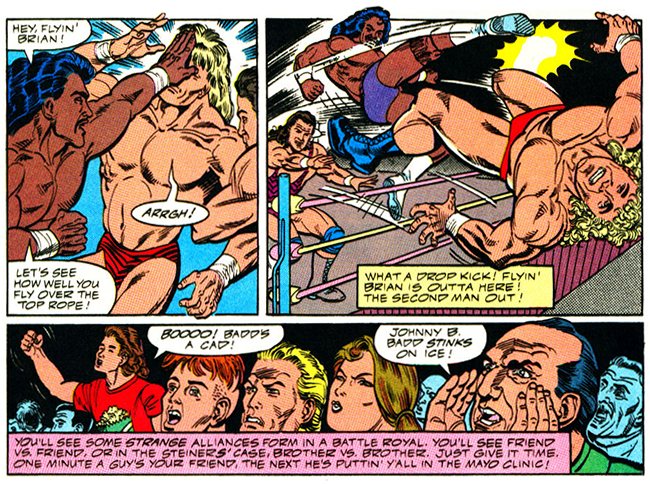
Ron Wilson is a competent artist, but what works in superhero books (like the sudden impossible leap in panel two above) doesn’t work in what should be a more grounded universe. Add in the terrible, bone-headed dialogue, and this book is both puzzling and infuriating…
And that’s before we are presented with the dead-eyed image that purports to be the face of Missy Hyatt, one of the most lovely women in wrestling circa 1992…

Do not stare too long, for Missy also stares into you, my friends. The battle rages in the ring, eliminating competitor after competitor, including the late Giant Gonzales (one of only two wrestlers who have passed since this comic was printed, the other being Flyin’ Brian Pillman, which is pretty good odds for a story this old using wrestlers of this vintage.) Johnny B. Badd does especially well, even calling out Sting, the United States champion…
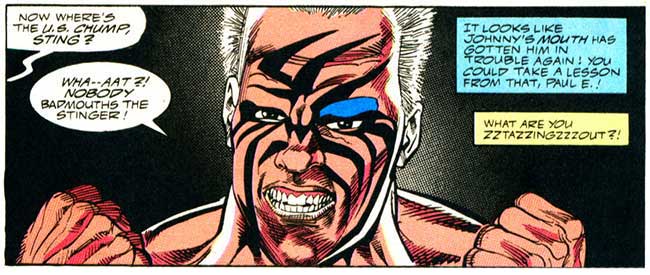
This comic is sooooo bad, you guys. Even the coloring is bad, featuring garish blotches of mismatched color in everyone’s ring gear, but omitting the bright colors of Sting’s face paint entirely. The result is just ugly, and it’s all I can do to stay with you as we suffer together. I find that the only way to do that is to run through wrestling trivia as I go, like reminding you that young Scott Steiner wore a magnificent mullet and wasn’t yet the ridiculously jacked, immobile muscleman he would become as Big Poppa Pump a few years later…
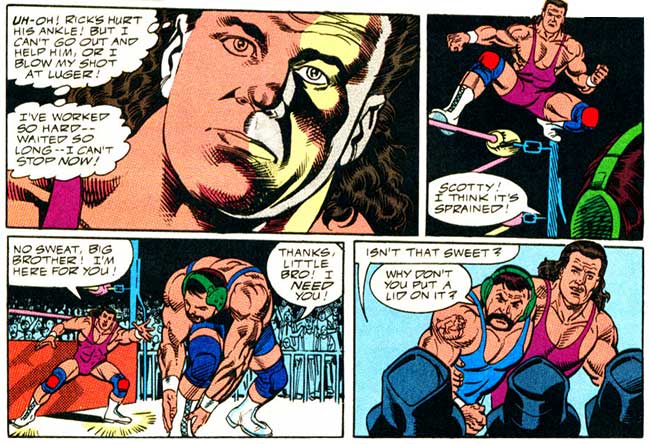
He also has (at least in this story) sufficient loyalty to his brother Rick to eliminate himself in the name of filial support, while Ron Simmons (who, a few months after this issue, would be crowned as first black world champion in wrestling history, later serving as the not-terrible half of the APA as Farooq) wipes out more competitors, his sights set on Lex Luger and the championship…
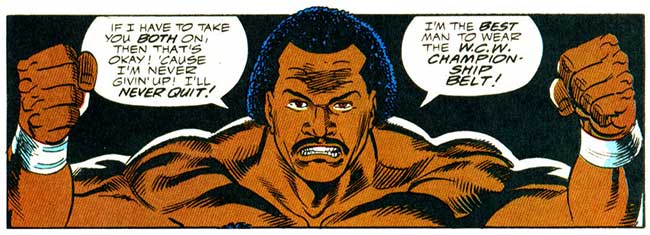
Absorbing a two-man beat down from Johnny B. Badd and The Diamond Studd, even outlasting the U.S. Champ, Sting (who is, was, and probably always will be the Franchise of WCW, even 17 years after its demise), Simmons is poised to take the prize…
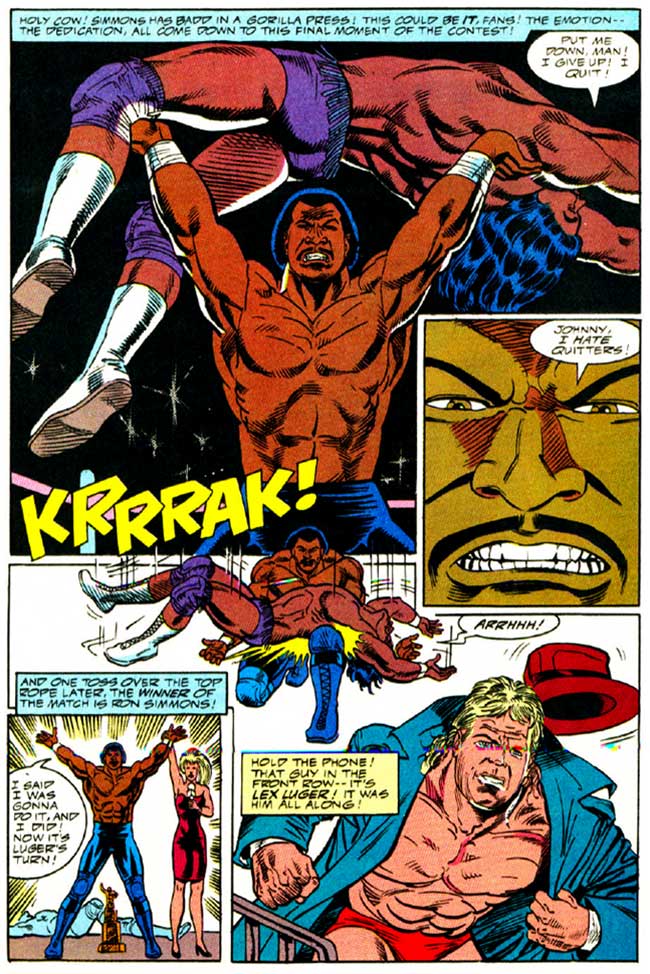
…but he forgot about Luger. And one thing that will always be true of comic books, Faithful Spoilerites, is that men named Lex are NOT to be trusted.
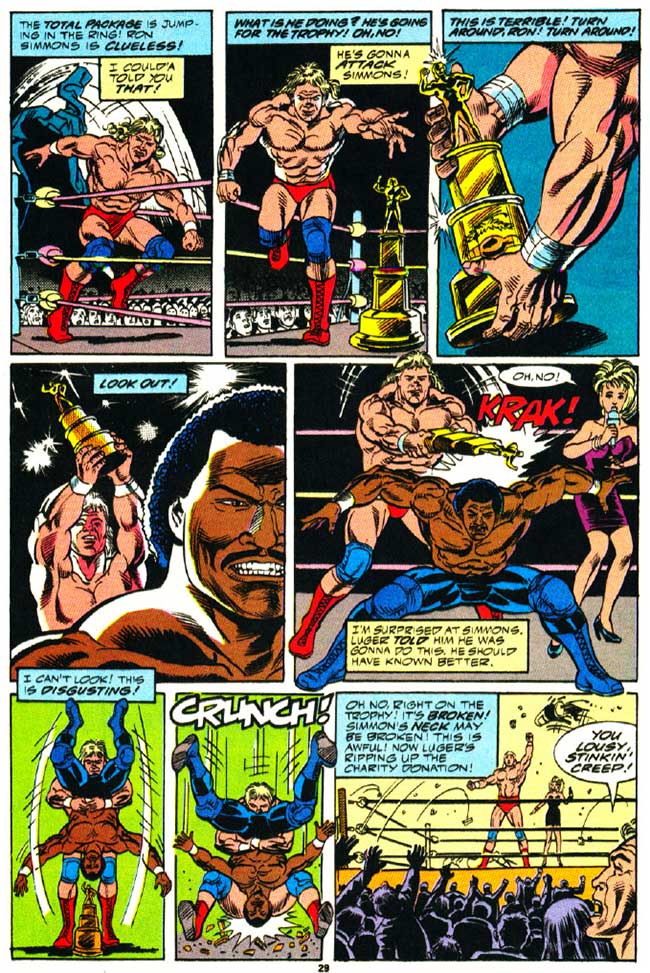
Luger’s heel ways leave Ron lying in the ring (which, I have to tell you, is better than the actual angle used in their 1992 feud, which had ugly racist overtones that did not belong in the 1990s) letting readers known exactly who their big supervillain is going to be in this series…

Marvel’s experimental collaboration with WCW ran 12 issues back in the day, at a time when wrestling was pretty moribund to begin with. The Rock N’ Wrestling days were gone, the Attitude Era was still in the future, and WCW’s squad was not particularly memorable. (Interestingly, though, one of the stars of this issue, Dustin “The Natural” Rhodes is still active as Goldust in WWE as of this writing.) WCW: World Championship Wrestling #1 is that rare comic that just doesn’t work on any level, with a plot that is barely perfunctory, dialogue that insults my intelligence of a wrestling fan AND as a comics fan, and while I appreciate Ron Wilson as a creator, the finished art here is forgettable and bland, leaving use with a comic that’s not even bad enough to hate and 1 out of 5 stars overall. The finished product is inconsistent, inexplicable and ill-advised, which serves as a metaphor for much of WCW’s actual product as well.
[taq_review]Dear Spoilerite,
At Major Spoilers, we strive to create original content that you find interesting and entertaining. Producing, writing, recording, editing, and researching requires significant resources. We pay writers, podcast hosts, and other staff members who work tirelessly to provide you with insights into the comic book, gaming, and pop culture industries. Help us keep MajorSpoilers.com strong. Become a Patron (and our superhero) today.


